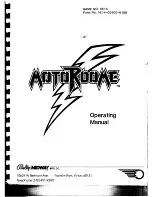
Rise of Flight - Iron Cross Edition
34
35
While piloting an aircraft, it is important to understand that you are operating a
machine with significant “energy”. This energy is contained in two forms: potential
energy (altitude) and kinetic energy (speed). These two energies are intercon-
nected and one can be gained at the expense of the other. Combined they
represent your total aircraft energy. In WWI aerial combat is became obvious to
pilots that you want to maintain a high level of aircraft energy at all times.
You can gain additional altitude by performing a steep climb or Immelmann, but
doing so will lower your speed. You can gain additional speed by diving or
performing a descending turn, but by doing so you will lose some of your
altitude.
Your engine can help to extend or lessen the effects on both altitude and speed,
but increased maneuvering drains both of these energies and affects your total
aircraft energy. The more intensive maneuvers you perform, the faster you lose
your energy. And in the long run the engine could stop compensating for such
intensive loss of energy and you will find yourself both without speed and
altitude.
That’s why, when in combat, you should remember when chasing the enemy that
too much intensive maneuvering is a bad thing. The winner of a dogfight is often
not the pilot who is constantly trying to get on the tail of the rival, but the pilot
with more patience and the ability to keep his aircraft’s energy high and use it at
the proper time.
An important feature of WWI fighters is their relatively bad controllability of the
roll axis with ailerons (when you move your joystick side to side). That’s why the
rudder is very important when flying WWI era aircraft. With the rudder you can
sometimes do more than even with the ailerons. However, the best way fly these
types of airplanes is to use both of these controls simultaneously. You should
always begin a turning maneuver with rudder and help yourself turn with the
ailerons. Experienced pilots can use a stall roll or “hammerhead” to great effect in
combat. A hammerhead is when the pilot pulls the stick back causing the plane to
shoot upwards thus lowering its speed and ability to climb, then simultaneously
pushing the rudder pedals to perform a sideways the turn. The end result is a high
angular velocity which can turn the plane around much quicker, which is
important in combat situations. However, this is a dangerous move, since a
mistake by the pilot will result in a stall and spin. This kind of maneuver is only
recommended for experienced pilots, but with practice you will be able to master
such aerobatics in Rise of Flight.






































